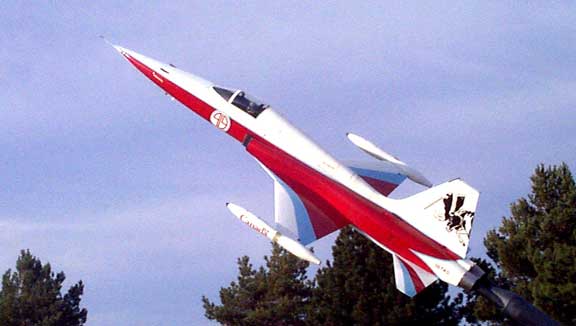 |
|
BAe Hawk 115 |
| Kamloops - Tuesday, November 13, 2001 By: Michael Townsend |
 I was on my way home Friday after school and I heard some jets scream by but was unable to locate them. In the past this was a very comforting sound, having grown up on airforce bases across Canada and in Europe. But because of Sept. 11 this sound brings other unsettling pictures to mind. Nevertheless my curiosity was peaked. I later heard on |
 |
 the radio that there were some airforce planes in town prepared to do a fly past for our local Nov. 11 remembrances. So I decided to take a look and the following pictures are the result. Pictures of the Hawk, some of the pilots, and the permanent plane we have on display at the airport. Tthe Hawk has taken the place of the Tutor as Canada's trainer. The pilots were from Germany, England, and Sumatra(??) and Canadians of course. Mike Townsend |
 |
 Mike is quite right these are BAe (British Airospace) 115 Hawks. Designed in the 1970s and widely used as training aircraft. When the NATO deal was made to have pilots from the alliance come to Canada to train it was decided to use this aircraft to replace the Canadair Tutor which we all associate with Mosse Jaw and the SnowBirds. The BAe 100 Hawk is a tandem seated aircraft but excellent for advance jet training. The United States has selected it as their advanced trainer replacing the Northrope T-38 |
 |
 that evolved into the F5 (Freedom Fighterer) or the CF-5 that was used during the Vietnam conflict and an example is mounted on a pilon at the Kamloops airport.(bottom picture) When Canada launched the NATO training programme McDonnald Douglas had the license to build the Hawk and Canada ordered its first batch from them but it was decided to make the project a private venture and the Hawks that went into service at Moose Jaw are built in Britian by BAe and upgraded to 115 from the 100 version with more avionics including the complex HUD (heads up |
 |
| display) you can see in this picture. This may also explain the extended nose that
is not part of the original design. Perhaps the most puzzling aspect of all this is the odd markings on these aircraft and non-standard Canadian appearance. These aircraft belong to Bombardier and to distinguish them from regular Canadian military aircraft they were given this dark blue paint job which is the same colour used during the Korean conflict by the U.S. navy and in the last years of World War II. Model aircraft builders will recognise this paint colour as being the colour used on the Avenger and early Navy Phantoms of the early fifties. For some time the United States Navy acrobatic team Blue Angels aircraft used this colour with gold highlights. If you would like to look over the performance specifications and the training programme NATO pilots follow on the basic Raython turbo prop Harvard and the advanced Hawk 115 check out the NATO training school's web site. You will have to scroll down the page a bit but on the Canadian Airforce web site they have pictures of the Hawk and explain the colour scheme. Timothy W. Shire |
 |